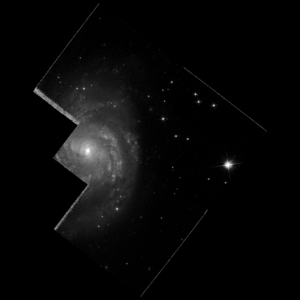NGC 2339
| Galaxy NGC 2339 |
|
|---|---|

|
|
| Photo from the Hubble Space Telescope | |
| AladinLite | |
| Constellation | Twins |
|
Position equinox : J2000.0 , epoch : J2000.0 |
|
| Right ascension | 07 h 08 m 20.3 s |
| declination | + 18 ° 46 ′ 46 ″ |
| Appearance | |
| Morphological type | SAB (rs) bc / AGN |
| Brightness (visual) | 11.7 mag |
| Brightness (B-band) | 12.5 mag |
| Angular expansion | 2.7 ′ × 2 ′ |
| Position angle | 175 ° |
| Surface brightness | 13.4 mag / arcmin² |
| Physical data | |
| Redshift | 0.007358 ± 0.000017 |
| Radial velocity | (2206 ± 5) km / s |
|
Stroke distance v rad / H 0 |
(95 ± 7) x 10 6 ly (29.2 ± 2.0) Mpc |
| history | |
| discovery | William Herschel |
| Discovery date | February 22, 1789 |
| Catalog names | |
| NGC 2339 • UGC 3693 • PGC 20222 • CGCG 085-040, 086-005 • MCG + 03-19-002 • IRAS 07054 + 1851 • 2MASX J07082054 + 1846490 • GC 1496 • H II 769 • h 434 • HIPASS J0708 + 18 | |
NGC 2339 is an active barred spiral galaxy with extensive star formation from Hubble type SBBC in the constellation Gemini on the ecliptic . It is estimated to be 95 million light-years from the Milky Way and about 75,000 light years in diameter.
The object was discovered on February 22, 1789 by the astronomer William Herschel with a 48 cm telescope .
